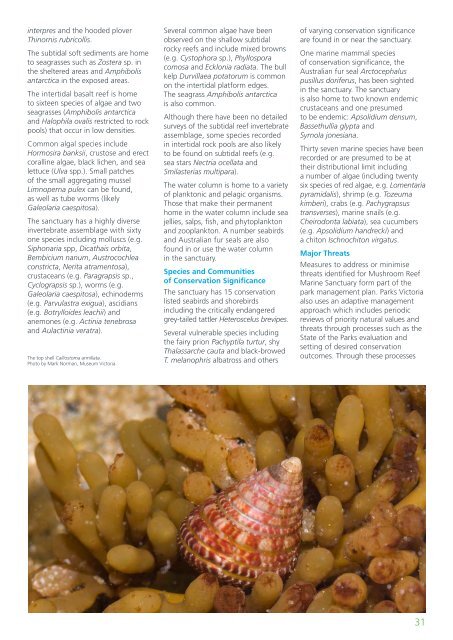Marine Natural Values Study Summary - Parks Victoria
Marine Natural Values Study Summary - Parks Victoria
Marine Natural Values Study Summary - Parks Victoria
You also want an ePaper? Increase the reach of your titles
YUMPU automatically turns print PDFs into web optimized ePapers that Google loves.
interpres and the hooded ploverThinornis rubricollis.The subtidal soft sediments are hometo seagrasses such as Zostera sp. inthe sheltered areas and Amphibolisantarctica in the exposed areas.The intertidal basalt reef is hometo sixteen species of algae and twoseagrasses (Amphibolis antarcticaand Halophila ovalis restricted to rockpools) that occur in low densities.Common algal species includeHormosira banksii, crustose and erectcoralline algae, black lichen, and sealettuce (Ulva spp.). Small patchesof the small aggregating musselLimnoperna pulex can be found,as well as tube worms (likelyGaleolaria caespitosa).The sanctuary has a highly diverseinvertebrate assemblage with sixtyone species including molluscs (e.g.Siphonaria spp, Dicathais orbita,Bembicium nanum, Austrocochleaconstricta, Nerita atramentosa),crustaceans (e.g. Paragrapsis sp.,Cyclograpsis sp.), worms (e.g.Galeolaria caespitosa), echinoderms(e.g. Parvulastra exigua), ascidians(e.g. Botrylloides leachii) andanemones (e.g. Actinia tenebrosaand Aulactinia veratra).The top shell Calliostoma armillata.Photo by Mark Norman, Museum <strong>Victoria</strong>.Several common algae have beenobserved on the shallow subtidalrocky reefs and include mixed browns(e.g. Cystophora sp.), Phyllosporacomosa and Ecklonia radiata. The bullkelp Durvillaea potatorum is commonon the intertidal platform edges.The seagrass Amphibolis antarcticais also common.Although there have been no detailedsurveys of the subtidal reef invertebrateassemblage, some species recordedin intertidal rock pools are also likelyto be found on subtidal reefs (e.g.sea stars Nectria ocellata andSmilasterias multipara).The water column is home to a varietyof planktonic and pelagic organisms.Those that make their permanenthome in the water column include seajellies, salps, fish, and phytoplanktonand zooplankton. A number seabirdsand Australian fur seals are alsofound in or use the water columnin the sanctuary.Species and Communitiesof Conservation SignificanceThe sanctuary has 15 conservationlisted seabirds and shorebirdsincluding the critically endangeredgrey-tailed tattler Heteroscelus brevipes.Several vulnerable species includingthe fairy prion Pachyptila turtur, shyThalassarche cauta and black-browedT. melanophris albatross and othersof varying conservation significanceare found in or near the sanctuary.One marine mammal speciesof conservation significance, theAustralian fur seal Arctocephaluspusillus doriferus, has been sightedin the sanctuary. The sanctuaryis also home to two known endemiccrustaceans and one presumedto be endemic: Apsolidium densum,Bassethullia glypta andSyrnola jonesiana.Thirty seven marine species have beenrecorded or are presumed to be attheir distributional limit includinga number of algae (including twentysix species of red algae, e.g. Lomentariapyramidalis), shrimp (e.g. Tozeumakimberi), crabs (e.g. Pachygrapsustransverses), marine snails (e.g.Cheirodonta labiata), sea cucumbers(e.g. Apsolidium handrecki) anda chiton Ischnochiton virgatus.Major ThreatsMeasures to address or minimisethreats identified for Mushroom Reef<strong>Marine</strong> Sanctuary form part of thepark management plan. <strong>Parks</strong> <strong>Victoria</strong>also uses an adaptive managementapproach which includes periodicreviews of priority natural values andthreats through processes such as theState of the <strong>Parks</strong> evaluation andsetting of desired conservationoutcomes. Through these processes31
















